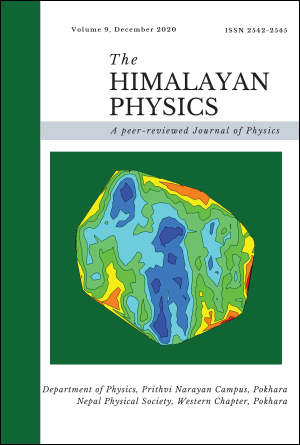First-principles study of C cites vacancy defects in water adsorbed Graphene
DOI:
https://doi.org/10.3126/hp.v9i01.40150Abstract
The electronic and magnetic properties of water adsorbed graphene (wad – G), single carbon (1C) atom vacancy defects in water adsorbed graphene (1Catom-vacancy – wad – G) and double carbon (2C) atoms vacancy defects in water adsorbed graphene (2Catom-vacancy – wad – G) materials are studied by first-principles calculations within the frame work of density functional theory (DFT) using computational tool Quantum ESPRESSO (QE) code. We have calculated the binding energy of wad – G, 1Catom-vacancy – wad – G and 2Catom-vacancy – wad – G materials, and then found that non-defects geometry is more compact than vacancy defects geometries. From band structure calculations, we found that wad – G is zero band gap semiconductor, but 1Catom-vacancy – wad – G and, 2Catom-vacancy – wad – G materials have metallic properties. Hence, zero band gap semiconductor changes to metallic nature due to C sites vacancy defects in its structures. We have investigated the magnetic properties of wad – G and its C sites vacancy defects materials by using Density of States (DOS) and Partial Density of States (PDOS) calculations. We found that wad – G is non- magnetic material. 1C atom vacancy defects in graphene surface of wad – G is induced magnetization by the re-bonding of two dangling bonds and acquiring significant magnetic moment (0.11 µB/ cell) through remaining unsaturated dangling bond. But, 2C atoms vacancy defects in graphene surface of wad – G induced low value of magnetic moment (+0.03 µB/ cell) than 1C atom vacancy defects in structure, which is due to no dangling bonds present in the structure. Therefore, non-magnetic, wad – G changes to magnetic, 1Catom-vacancy – wad – G and, 2Catom-vacancy – wad – G materials due to C sites vacancy defects in wad – G structure. The 2p orbital of carbon atoms has main contribution of magnetic moment in defects structures.
Downloads
Downloads
Published
How to Cite
Issue
Section
License
This license enables reusers to distribute, remix, adapt, and build upon the material in any medium or format for noncommercial purposes only, and only so long as attribution is given to the creator. If you remix, adapt, or build upon the material, you must license the modified material under identical terms.




